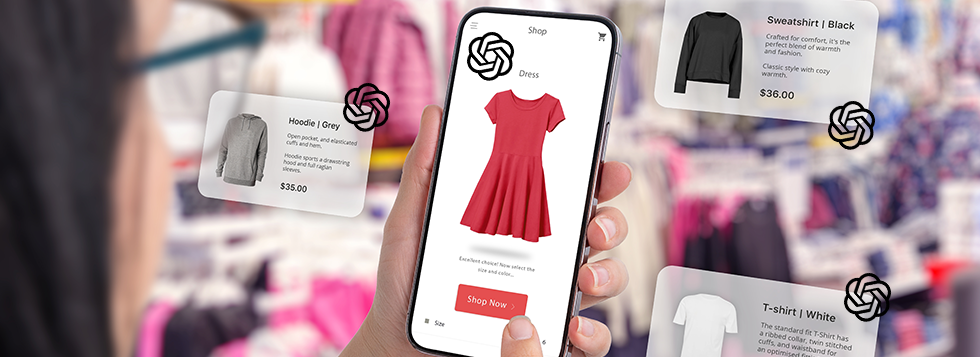OpenAI’s recent rollout of the ChatGPT shopping feature is a significant development in the world of e-commerce. By integrating AI-driven, personalized product recommendations into a conversational format, ChatGPT aims to transform the online shopping experience. For e-commerce businesses, this means new opportunities and new challenges. Understanding how this feature works and adapting accordingly is key to staying relevant and competitive in the ever-evolving digital marketplace. Here’s a deeper dive into what e-commerce businesses need to do to take full advantage of this shift.
How ChatGPT’s Shopping feature works
The new shopping feature within ChatGPT allows users to receive personalized product suggestions based on their queries. For example, if a customer asks, “What’s the best coffee machine under $200 for small kitchens?” ChatGPT will provide recommendations sourced from user reviews, expert opinions, and online forums like Reddit, all without relying on traditional paid advertisements.
Although ChatGPT doesn’t process transactions directly, it provides users with curated product recommendations and links to the retailer’s website, allowing them to complete the purchase on the retailer’s platform. This feature is all about enhancing product discoverability in a natural, organic, and conversational way.
Why E-Commerce businesses need to adapt
As AI-powered shopping assistants become more prevalent, businesses will need to adjust their digital strategies to maintain a competitive edge. Here’s why:
1) The shift toward organic discoverability:
ChatGPT prioritizes non-sponsored product recommendations. Unlike traditional search engine results, which often highlight paid ads, ChatGPT offers more organic results based on product quality and user satisfaction. For e-commerce businesses, this means that optimizing for AI recommendations is essential.
2) Consumer expectations are evolving:
Consumers increasingly seek a seamless and intuitive shopping experience. They are turning to AI assistants to help them make decisions faster and with more confidence. Businesses that fail to adapt to these evolving expectations risk being left behind.
3) Rising importance of content and data quality:
With ChatGPT recommending products based on curated content, businesses that invest in high-quality content, accurate product information, and transparent user reviews will have a better chance of being featured in the AI’s results.
What E-Commerce businesses should do to stay relevant
To stay competitive and maximize the benefits of ChatGPT’s shopping feature, e-commerce businesses should take the following steps:
1. Optimize Product Listings for AI recognition
The foundation of getting noticed in ChatGPT’s shopping feature starts with your product listings. AI systems thrive on structured and comprehensive data, so ensuring that your product titles, descriptions, and metadata are clear, accurate, and detailed is crucial.
-
Product titles: Make sure titles are concise yet descriptive. Include important attributes such as brand, model, color, size, and any other relevant details
-
Product descriptions: Provide clear, informative, and detailed descriptions. Highlight key features, benefits, and potential use cases that are relevant to consumers’ needs.
-
High-quality images: Visuals play a critical role in conversion, so having high-quality images, lifestyle shots, and possibly even 360-degree views can help customers make informed decisions.
2. Implement structured data and schema markup
Structured data is a way of formatting product information (using schema markup) so that search engines and AI can better understand and categorize your offerings. This is especially important for AI systems like ChatGPT, which rely on structured data to deliver precise product recommendations.
Structured data should include key product attributes such as:
-
Product name, description, and SKU
-
Price and availability
-
Customer reviews and ratings
-
Shipping and return policies
This will help ensure that your products are properly categorized and can be discovered by AI systems, improving your chances of being included in personalized recommendations.
3. Prioritize Content Marketing and authenticity
Since ChatGPT doesn’t rely on paid ads for its product recommendations, creating high-quality, organic content is essential. Focus on producing valuable content that resonates with your audience and helps build trust in your brand.
-
Product reviews and testimonials: Encourage customers to leave detailed reviews and share their experiences. Authentic, positive reviews can significantly impact AI’s decision-making process when curating product recommendations.
-
Educational content: Providing guides, tutorials, or blog posts that help customers understand how to use your products or choose the best option for their needs can make a big difference. This content will help build your authority and improve your product’s visibility in AI-driven recommendations.
-
User-generated content: Featuring user-generated content, such as photos or videos from real customers, not only builds authenticity but also gives your products a more relatable appeal.
4. Ensure seamless integration with E-Commerce platforms
For your business to make the most of ChatGPT’s shopping feature, your product feed must be easily integrated with the AI system. This means ensuring that your product data is in the right format and your e-commerce platform is set up for easy feed management.
-
API Integrations: Ensure your platform can integrate with ChatGPT and other AI-driven platforms to automatically update product information and maintain its accuracy and timeliness.
-
Optimized user experience: Ensure your website is optimized for seamless navigation, quick load times, and a smooth checkout process. If ChatGPT directs a user to your site, they should have a smooth, frustration-free experience.
5. Track performance and optimize continuously
The landscape of AI and conversational commerce is evolving rapidly. To remain competitive, it is essential to continually monitor the performance of your products in AI-driven shopping results and adjust your strategies accordingly.
-
Analyze data: Monitor product interactions, sales conversions, and traffic from AI-generated referrals. This data will help you understand which products are performing best and what kind of content is resonating with customers.
-
Test and iterate: Just as you would with any other digital marketing effort, A/B testing your product listings, imagery, and content will help you refine your approach and improve your performance in AI recommendations.
Conclusion
The new ChatGPT shopping feature represents a significant shift in how consumers shop online, and it offers both exciting opportunities and challenges for e-commerce businesses. By optimizing product listings, implementing structured data, focusing on organic content, and ensuring seamless integrations with your e-commerce platform, businesses can position themselves for success in this new era of AI-driven commerce.
Adapting to these changes is not just about staying competitive; it’s about embracing the future of digital shopping and delivering a more personalized, intuitive experience for consumers. The businesses that get ahead of this trend will be the ones that thrive in the AI-powered future of e-commerce.


